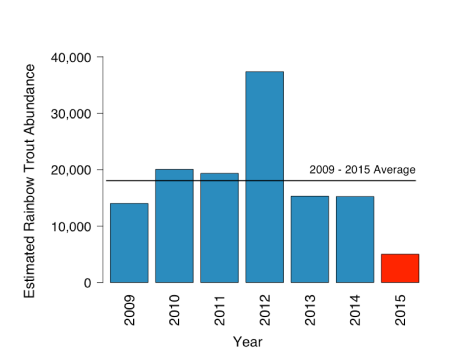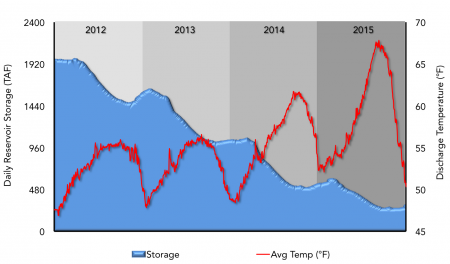Monday August 15, 2016

The Stanislaus River is home to one of the largest populations of rainbow trout in California’s Central Valley, but a new report shows the fish have suffered a precipitous decline during the state’s ongoing drought. Every summer since 2009, FISHBIO scientists have snorkeled the Stanislaus River to conduct an annual trout count. The results of our 2015 survey show that rainbow trout abundance declined by 75 percent from an average of 20,000 over the previous six years, to just 5,000 fish in 2015 (download report). This troubling trend comes on the heels of very warm water temperatures in 2014 and 2015 (see Figure 1). Worse is likely in store for the fish because trout numbers tend to decline one year after a hot summer, and 2015 was even warmer than 2014 (with 2016 shaping up to be a warm year too). As we prepare to begin our annual Stanislaus River trout count, we’re expecting to find even fewer fish this year. We describe the current plight of the fish in a new video, The Future of Rainbow Trout on the Stanislaus River.
Rainbow trout are the resident, river-dwelling form of the fish Oncorhynchus mykiss. This species also has a migratory form known as steelhead, which is considered “threatened” in the Central Valley under the federal Endangered Species Act. Steelhead often migrate from the river to the ocean after one or two years of age, meaning that all the young trout we see in the Stanislaus River downstream of Goodwin Dam have the potential to become steelhead.

With funding from the Oakdale and South San Joaquin irrigation districts as well as Tri-Dam Project, FISHBIO scientists have conducted annual snorkel surveys to count rainbow trout on the Stanislaus River starting in 2009, which allows us to track the fish’s abundance over time and across a range of conditions. Our yearly trout estimates from 2009-2014 average about 20,220 trout in the river, and had never dipped below 14,000 fish until 2015. This healthy abundance is due in part to the river’s high quality habitat, particularly in Goodwin Canyon, where fast-moving water, boulders, and other features offer a diversity of hiding places and food for the fish. However, in 2015 the number of trout we counted per river mile dwindled in the canyon by about 80 percent.
The average daily water temperature in the Stanislaus River reached 69 degrees Fahrenheit at Knights Ferry in August of 2015, which is higher than any summer water temperature recorded since 1998. These warm temperatures were related to the exceedingly low water level in New Melones Reservoir upstream of Tulloch and Goodwin dams, which was then at about 12 percent of capacity (see Figure 2).

Trout and salmon prefer cooler water, so to protect these fish, the reservoir should ideally be managed to maintain a reserve of deeper, cold water. However, by summer 2014, the level of the reservoir had dropped too low for the water to remain cool, so the water released from New Melones was warm during that summer, and even warmer during summer 2015. This likely had serious consequences both for trout living in the river and for eggs they laid during the winter.
The prevailing strategy in river fisheries management is that “more flow equals more fish,” and certain volumes of water are prescribed to flow down the Stanislaus River each year to keep the rainbow trout population healthy. However, our new report shows that these prescribed flows actually have had little effect on rainbow trout numbers over the years. With the exception of extremely high flows that were released for flood control in 2011, water temperature has played a much bigger role than river flow in determining rainbow trout abundance—so much so that rainbow trout have declined even though flows have been relatively high in recent years, because water released from the reservoir has been too warm. We are currently preparing to conduct our annual snorkel survey, which usually takes place in late summer or early fall, and covers sections of the river from the base of Goodwin Dam to Oakdale. Although the Stanislaus rainbow trout population held strong for several years, it appears that the ongoing drought and water management decisions have taken a heavy toll – our survey will reveal how serious their situation continues to be.
This post featured in our weekly e-newsletter, the Fish Report. You can subscribe to the Fish Report here.
